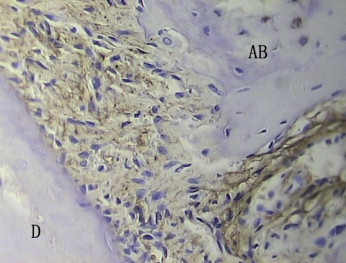Introduction
Our objectives were to determine the effects of simvastatin on relapse and periodontal tissue remodeling after experimental tooth movement in rats and to explore the molecule mechanism.
Methods
Thirty-two adult male Wistar rats were randomly divided into 2 groups. Bilateral mandibular first molars were moved mesially with nickel-titanium closed-coil springs in both groups. On the 21st day, the springs were removed, and dental casts were made. Animals in the experimental group began receiving simvastatin at a dose of 2.5 mg per kilogram per day for 4 weeks, and animals in the control group received 0.9% sodium chloride. The results were evaluated by model measuring and immunohistochemistry staining.
Results
Relapse distances and relapse percentages were decreased in the simvastatin group compared with the controls. Osteoprotegerin expression increased, and RANKL decreased.
Conclusions
These results indicate that simvastatin inhibits the bone-resorbing activity of osteoclasts while stimulating bone formation, probably by controlling the ratio of local osteoprotegerin to RANKL in the periodontal tissues. Therefore, it might be useful for retention.
Editor’s comment
The relapse of teeth that have been aligned continues to be a vexing problem for both patients and orthodontists. Investigators are attempting to identify new and different ways to provide increased tooth stability without total reliance on long-term retention. For obvious reasons, most of these studies are conducted on animal models. This research from JiLin University in China was designed to investigate the effect of simvastatin on relapse. The plan was to also explore the molecular mechanism after orthodontic tooth movement by using the immunohistochemical technique to examine the relationship of simvastatin with OPG and RANKL.
A recent study showed that the use of relaxin was successful in remodeling soft tissues and preventing tooth relapse in a dog model by gingival injection. The authors of this article then hypothesized that stimulating bone formation might reduce dental relapse. It is already known that several statins, such as simvastatin and lovastatin, have anabolic effects on bone metabolism in vivo. It has also been clarified that statins could stimulate osteoblastic bone formation in vitro and in vivo. The primary purpose of this study was to determine whether simvastatin by systemic administration has an effect on the relapse of teeth after orthodontic movement. It is suggested that you read the entire article online for a thorough description of the methods used in this study. The entire discussion of changes noticed is also well worth reading. These observations confirm that simvastatin promotes bone formation in the periodontal tissues after orthodontic tooth movment. The results indicate that simvastatin can inhibit the bone-resorbing activity of osteoclasts while stimulating bone formation. This is probably caused by controlling the ratio of local OPG/RANKL in periodontal tissues. More studies are obviously needed to relate these findings to improving long-term clinical outcomes.





